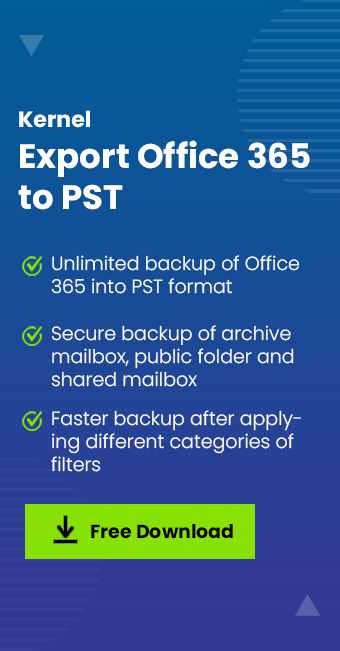Read time 4 minutes
Security breaches are prevalent in the cloud-based platforms in spite of Microsoft’s repeated attempts to secure users and their valuable information. User security gets compromised if a balance between user accessibility and risk avoidance factors are not configured properly. With malware and data hacking attempts increasing every day, protecting your mailboxes against attacks in real time is a tough challenge. Microsoft has introduced several protection policies to strengthen the loopholes in the security layer of Microsoft 365 mailbox.
Employ reliable methods to secure Microsoft 365 mailboxes
Businesses should adopt such steps to prevent malicious attachments from messing up with your messaging environment. User security must be enhanced with effective measures to protect your environment when users click malicious links. The chances of Office 365 data breach can be minimized by resorting to the following recommended practices.
Configure multi-factor authentication (MFA)
Enabling MFA, or two-factor authentication, is a simple justification of its name, which means two layers of protection to secure Microsoft 365 mailboxes. This feature works efficiently by applying a two-level login stage, which requires you to fill in specific details. It will also remember past users who logged out to simplify the process. This feature is more effective in defending business data from in-house as well as external infiltration. Once configuring MFA, you must follow suitable steps to enhance Microsoft 365 Tenant’s MFA effectiveness.
Use Office 365 Cloud App Security
Establish policies in accordance with your business requirements to detect incongruous activities and initiate campaigns to probe into them. Set up notification alerts with Office 365 Cloud App Security so that admins can assess bizarre or anomalous user activity, that includes downloading large-sized data files, repeated unsuccessful sign-in attempts, or sign-ins from an unknown or dangerous IP addresses.
Secure Office 365 mail flow in EOP
Activate the mail flow feature in Exchange Online Protection (EOP) that filters the mail body. It checks the message & the sender identity of each email messages and if found any threat then stops it & notifies you. This practice protects important conversations and files against malware, viruses, and malignant URLs disseminated through emails.
SPF Enablement
At the time of setting up of Office 365, a user is instructed to configure DNS to work with Office 365. SPF (Sender Protection Framework) is a distinct record type which is used to inform other mail channels whether the email is from an authenticated and protected system. SPF should be established to prevent spoofing. So, with a custom domain, set up SPF, DKIM, and DMARC.
Configuration of Data Loss Prevention (DLP)
DLP permits you to determine classified data and devise policies that restrict your users from sharing the data with the external users. DLP works across Microsoft 365 including SharePoint Online, Exchange Online, and OneDrive to prevent the users from being non-compliant with the policies. DLP helps to secure Office 365 mailboxes by wiping out the vulnerability of sharing data fortuitously or intentionally.
Implementing Mailbox audit logging
By enabling this feature, you can browse the audit log in the Office 365 Security & Compliance Center to seek out for the users who have logged into your mailboxes. It can also give information on actions performed by a delegated user, the mailbox owner, or an administrator. Mailbox audit logging is not enabled by default. You can activate audit logging feature for all user mailboxes in Microsoft 365 by applying Exchange Online PowerShell.
Applying Customer Lockbox
Being an Office 365 admin, you can implement Customer Lockbox feature to control the access of your data by a Microsoft support engineer during a session of technical troubleshooting. Customer Lockbox lets you reject or approve the access request. Once it’s approved, the engineer can access the data until they want and once the problem is resolved, the request is closed.
Use Office 365 Secure Score
Secure Score, the Office 365 security analytics tool from Microsoft, suggests methods of reducing risks in Microsoft 365. Secure Score studies your Microsoft 365 settings and activities, draws a comparison to the security standard set by Microsoft, and gives you a score. It’s a feasible way to kickstart the implementation of a number of enhanced security controls that Microsoft offers us.
Third party solutions to secure Microsoft 365 mailboxes
The aforesaid recommendations obviously help in securing Microsoft 365 data. But all the above methods have some limitations within that’s why we suggest using a third-party solution for Microsoft 365 backup. Kernel Office 365 Backup & Restore is one such pragmatic tool that saves Exchange/Microsoft 365 mailboxes as PST files. It executes both backup and import activities and can resolve your concerns related to security and protection of your Microsoft 365 mailboxes.
Some of the notable attributes of this software include
- Backup archive mailboxes, mailboxes and public folders.
- Import PST to archive mailboxes, mailboxes and public folders.
- Multiple Mailbox backup and PST import using CSV file.
- Backup of on-premises and hosted Exchange Server mailboxes.
- Incremental backup and recovery of mail data by skipping the previously saved data.
Conclusion
Cloud-based businesses’ primary concern is to secure Microsoft 365 mailboxes & protect their sensitive data from growing external or internal threats. We have understood that even after following multiple precautionary steps by Microsoft mentioned above, the risk of data loss is possible. So, we suggest you integrate the advanced Kernel Export Office 365 to PST tool, which helps to backup data easily in the desired format. However, to increase the protection capabilities, you need to configure Office 365 security and use native tools for effective Hybrid management.








